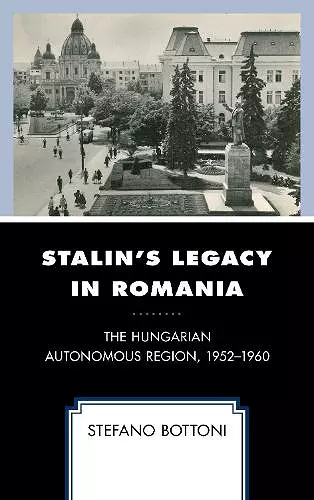Stalin's Legacy in Romania
The Hungarian Autonomous Region, 1952–1960
Format:Hardback
Publisher:Bloomsbury Publishing PLC
Published:29th May '18
Currently unavailable, and unfortunately no date known when it will be back

This study explores the little-known history of the Hungarian Autonomous Region (HAR), a Soviet-style territorial autonomy that was granted in Romania on Stalin’s personal advice to the Hungarian Székely community in the summer of 1952. Since 1945, a complex mechanism of ethnic balance and power-sharing helped the Romanian Communist Party (RCP) to strengthen—with Soviet assistance—its political legitimacy among different national and social groups. The communist national policy followed an integrative approach toward most minority communities, with the relevant exception of Germans, who were declared collectively responsible for the German occupation and were denied political and even civil rights until 1948. The Hungarians of Transylvania were provided with full civil, political, cultural, and linguistic rights to encourage political integration. The ideological premises of the Hungarian Autonomous Region followed the Bolshevik pattern of territorial autonomy elaborated by Lenin and Stalin in the early 1920s. The Hungarians of Székely Land would become a “titular nationality” provided with extensive cultural rights. Yet, on the other hand, the Romanian central power used the region as an instrument of political and social integration for the Hungarian minority into the communist state. The management of ethnic conflicts increased the ability of the PCR to control the territory and, at the same time, provided the ruling party with a useful precedent for the far larger “nationalization” of the Romanian communist regime which, starting from the late 1950s, resulted in “ethnicized” communism, an aim achieved without making use of pre-war nationalist discourse. After the Hungarian revolution of 1956, repression affected a great number of Hungarian individuals accused of nationalism and irredentism. In 1960 the HAR also suffered territorial reshaping, its Hungarian-born political leadership being replaced by ethnic Romanian cadres. The decisive shift from a class dictatorship toward an ethnicized totalitarian regime was the product of the Gheorghiu-Dej era and, as such, it represented the logical outcome of a long-standing ideological fouling of Romanian communism and more traditional state-building ideologies.
Stefano Bottoni’s history of the short-lived Hungarian Autonomous Region (HAR), a Soviet-inspired experiment that circumscribed one-third of Romania’s Hungarian population inside a territorial administrative unit in the heart of pre-Ceau?escu communist Romania, joins a growing and important body of scholarship on east central Europe analyzing the entangled histories of peoples, places, and periods in a particular region... The real virtue of the author’s work is in the assemblage and skillful deployment of Hungarian and Romanian-language archival sources, oral histories, and an array of secondary sources within a compelling narrative and taut analytical framework. . . . It is now the definitive work, in any language, on this rather specialized topic, and stands out as a seminal case study in the building and dismantling of a Stalinist ecosystem in Europe’s eastern periphery. * Slavic Review *
A particular merit of Stefano Bottoni’s unique study is his instructive analysis of the genesis of the Hungarian Autonomous Region (HAR) and of what he terms its ‘Stalinist eco-system,’ one which confronted questions of political ideology, national and cultural identity, and economic backwardness. As the author points out, the creation of this region, along with the Yugoslav experiment, was the only example of integrative minority policy in postwar East-Central Europe, and represented an attempt to solve a deeply rooted national question by giving administrative ‘autonomy’ to a predominantly Hungarian region of Transylvania. The ideological underpinning of the region, dictated to the Romanian Party by the Soviet leadership in 1952, followed the Bolshevik pattern of territorial autonomy elaborated by Lenin and Stalin in the early 1920s. The Hungarians of the Region became a ‘titular nationality’ and were accorded significant cultural rights. However, the Romanian leadership also used the region as an instrument of political and social integration of the Hungarian minority into the communist state. -- Dennis Deletant, Georgetown University
Stefano Bottoni’s book on the Hungarian Autonomous Region in socialist Romania is revelatory in its details of high politics, the history of communism, and everyday life. Bottoni has used Hungarian, Romanian, and Soviet sources meticulously to tell a lively, convincing, and important story of Stalin’s imposition of a territorial solution to Romania’s most bewildering national problem. He sets this in the broad context of longue durée Transylvanian history, postwar communism and nationalism, the purges, the thaw, intra-bloc conflict, and ethnic politics. -- Irina Livezeanu, University of Pittsburgh
ISBN: 9781498551212
Dimensions: 230mm x 159mm x 31mm
Weight: 853g
422 pages